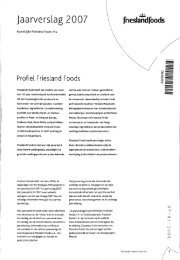Pallet-Management-Services - AFM
Pallet-Management-Services - AFM
Pallet-Management-Services - AFM
You also want an ePaper? Increase the reach of your titles
YUMPU automatically turns print PDFs into web optimized ePapers that Google loves.
Risk management<br />
Our internal risk management policies are integral parts of how<br />
we plan and execute our business strategies. We use a set of<br />
internal risk management and control systems to anticipate,<br />
measure, monitor and manage our exposure to risk. The most<br />
important of these are our enterprise-wide processes for<br />
strategic planning, management reporting and internal audit. We<br />
assess the installed control systems as adequate and effective.<br />
The coordination of these processes and procedures to ensure<br />
that our Board of Managing Directors, Executive <strong>Management</strong><br />
Committee and Supervisory Board are informed about material<br />
risks on a timely basis.<br />
In 2006 the Company has completed its internal audit function<br />
and has reached a full internal audit coverage of its European<br />
and USA businesses. Additionally a compliance officer function<br />
was installed, in order to oversee the Company’s corporate<br />
compliance program.<br />
Below we describe the major categories of risks that could<br />
materially affect our business, our financial condition and<br />
our results of operations. The risks we describe here are not<br />
necessarily the only ones we face. Additional risks not known to<br />
us, or that we now consider less significant, could also adversely<br />
affect our business.<br />
Competition<br />
We face competition in all industry sectors in which we operate.<br />
We expect aggressive competition from other reusable container<br />
providers and from the traditional packaging companies, in<br />
particular producers of cardboard boxes. In addition, there are<br />
relatively few barriers that prevent entry on a local or regional<br />
level into the traditional packaging and pallet industries. The<br />
effect of this competition could limit our ability to grow, increase<br />
pricing pressure on our products, and otherwise affect our<br />
financial results.<br />
The market for pallet recycling services is highly fragmented<br />
and competitive, resulting in intense pricing competition. Other<br />
pallet systems may include pallets fabricated from non-wooden<br />
components like plastic as cost-effective, durable alternatives<br />
to wooden pallets. Increased competition from pallet pooling<br />
companies or providers of other alternatives to wooden<br />
pallets could make it more difficult for us to attract and retain<br />
customers and may force us to reduce prices, which may<br />
decrease our profitability.<br />
| FINANCIAL REPORTING | MANAGEMENT’S DISCUSSION AND ANALYSIS |<br />
Retail relationships<br />
Our RPC-<strong>Management</strong>-<strong>Services</strong> business segment is<br />
dependent on our relationships with a relatively small number<br />
of large retailers. Our inability to maintain these relationships or<br />
cultivate new relationships on similar terms will impair our ability<br />
to remain competitive in the markets in which we operate.<br />
Our <strong>Pallet</strong>-<strong>Management</strong>-<strong>Services</strong> business segment sources the<br />
majority of our pallets for reconstruction from businesses that<br />
use pallets, including large and small retailers.<br />
The loss of one or more of these retail relationships would have<br />
a material negative impact on our revenues, profitability, and<br />
cash flows.<br />
RPC-<strong>Management</strong>-<strong>Services</strong>’ pool risks<br />
Despite our experience with container pooling and transport, and<br />
the relative durability and reliability of RPCs, our pool of RPCs<br />
is subject to shrinkage due to unforeseen loss and damage<br />
during transport in the product distribution cycle. Increased loss<br />
of or damage to RPCs may increase our costs in maintaining<br />
our current RPC-<strong>Management</strong>-<strong>Services</strong>’ pool, thus requiring<br />
additional capital investments, which could limit our profitability.<br />
We have implemented operational, logistic and analytical tools in<br />
order to reduce and minimize those risks.<br />
Supplier risk<br />
We procure RPCs used in our RPC-<strong>Management</strong>-<strong>Services</strong>’<br />
business exclusively from two suppliers under separate contracts<br />
for our European and US businesses. Our RPC-<strong>Management</strong><br />
<strong>Services</strong>’ operations depend upon obtaining deliveries of RPCs<br />
on a timely basis and on commercially reasonable terms. We<br />
have maintained long-term relationships with these suppliers.<br />
If these suppliers ever become unwilling or unable to supply us<br />
with RPCs at all or on conditions acceptable to us, we may be<br />
unable to find alternative suppliers on a timely or cost-effective<br />
basis. This would limit our ability to supply our customers with<br />
RPCs on a timely basis and, thus, adversely affect our results of<br />
operations.<br />
Credit risk<br />
We provide certain of our customers customary financing for our<br />
sales to them. We face a number of general risks in providing<br />
this financing, including delayed payments from customers or<br />
difficulties in the collection of receivables. We manage these<br />
credit risks using defined processes for assessing customer<br />
creditworthiness and through our group emphasis on collecting<br />
receivables fully and timely.<br />
63
















